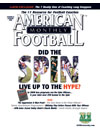AMERICAN FOOTBALL MONTHLY THE #1 RESOURCE FOR FOOTBALL COACHES
Article CategoriesAFM Magazine
|
Utilizing Play Action Passes With in Your Offenseby: Charlie StubbsFormer Offensive Coordinator, University of Louisville © More from this issue To win consistently: Offenses – Must be able to run the ball. There are various styles of running the football effectively. Some like ISO, Power, Toss, Counter, Option etc. Other methods include Zone, ZoneRead, Speed Sweep, Reverses. Defenses – Must be able to stop the run. They must force offenses to be one dimensional and predictable. High powered offenses must complement their runs with a versatile Play Action Passing Game. It is important to slow down the pursuit of the defense. Examples: 1. Aggressive linebacker/safety play 2. Flat (Down the Line Play) by defensive ends. When designing a P.A.P. scheme you must know the particular defender(s) or defensive technique that you are trying to exploit. Here are three examples of utilizing play action passes within your offense: The Snag ....The full article can only be seen by subscribers. Subscribe today!
|
|
|||||||
| HOME |
MAGAZINE |
SUBSCRIBE | ONLINE COLUMNISTS | COACHING VIDEOS |
Copyright 2025, AmericanFootballMonthly.com
All Rights Reserved





